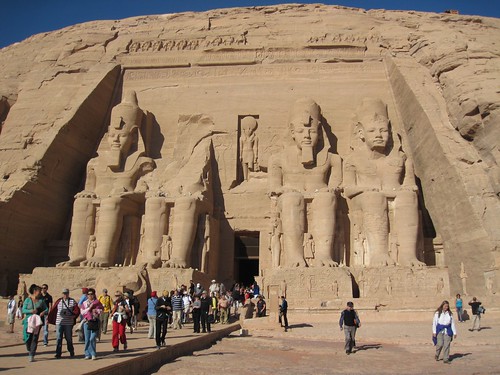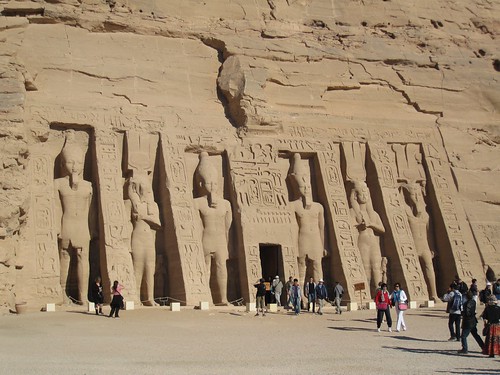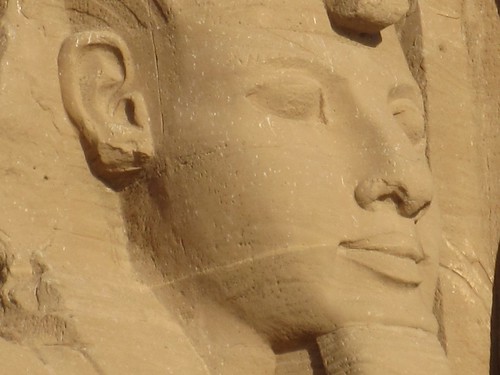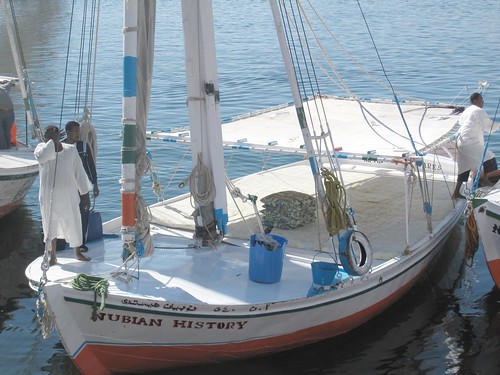I told you about the Temple of Karnak, the donkey ride, the Valley of Kings and the Temple of Queen Hatshepsut. That was all accomplished in about a day and a half in and around Luxor. Not being ones to linger when there are miles to be driven and antiquities to be viewed, we hightailed it out of Luxor at the first opportunity and drove to Aswan where I had the Weird Food birthday supper you’ve already heard about.
That night we all tried to get to sleep early because there was a very very early start scheduled for the next day. We were going to see the Great Temple of Abu Simbel, built by Ramses II (who was not a guy who did things halfway). It’s a magnificent site, but it’s also located in the far south of Egypt in a very sparsely inhabited area. The 280 km drive from Aswan to Abu Simbel is apparently too dangerous to be undertaken privately, so twice a day (three times during high season) a huge convoy of up to 60 vehicles forms up in Aswan and proceeds to the site with a police escort. And when do these convoys leave? The first one leaves a the punishing hour of 4:00 am. Naturally, we decided to take the second one so we got to leave a the much more comfortable hour of 4:30 am. Yup. The alarm went of at 3:15 am and we were instructed to be in the lobby ready to go at 4:00. Nice. It would be a three hour drive in the convoy to the Temple, where we’d then have about two hours to look around, and then we’d have to report back at 10:00 am to get into the return convoy back to Aswan. Oh, and of course the trip to Abu Simbel was not included in my tour, so I got to pay an additional 80 USD for the whole business. I really hoped this turned out to be worthwhile.
 The Temple of Abu Simbel. Those statues in front are close to 66’ tall. And the place is so important and famous that this scene is depicted on the Egyptian £1 note.
The Temple of Abu Simbel. Those statues in front are close to 66’ tall. And the place is so important and famous that this scene is depicted on the Egyptian £1 note.
I think it was. The logistics of getting to the site are definitely annoying, but when you get there it really is quite magnificent. As with the Valley of Kings, no cameras were allowed inside the temples. I think this is to help preserve the colours of the painted decorations on the walls inside (I run into this a lot – can anyone tell me whether flash photography really degrades paint? Or is this all just an excuse to try and get people to buy the professionally produced photos in the gift shop?). At least Abu Simbel still allowed photography outside – even outdoor photography is now banned in the Valley of the Kings. Merely being in possession of a camera there can net you a fine of £3,000 ($600). Actually being caught using it will cost you £5,000 ($1,000). Ahmed told us this is because too many people were sneaking cameras inside the painted tombs and then bribing the local guards to let them take photos. As usual, the countless jerks of the world have ruined it for everyone.
Here’s the other problem with the convoys – they create a huge glut of people who all arrive at the same place at the same time to see exactly the same thing. The crowds inside the big temple after we got there were awful. And of course everywhere you looked there were people taking photos, even though the local guards were making people put their cameras away. Naturally, it’s also forbidden to touch the walls inside the temple – not only is the original paint still present in some places, but most of the hieroglyphs are actually carved into the rock, not just painted. Nevertheless I saw people touching, and even leaning against the walls. There was one particularly miserable bunch – a Russian family consisting of a mom, dad and two little girls. As ai was standing nearby one of the little girls reached out to touch the carving of a figure in a side chamber of the main temple. I was a bit surprised but figured she was young and didn’t know better and would soon be corrected by a parent. Instead, dad came over and joined in the fun and I watched them trace over the whole carving with their fingers. I had to just leave the room it made me so mad. People are odious.
 The facade of the smaller temple, which Ramses built for his wife, Queen Nefertari
The facade of the smaller temple, which Ramses built for his wife, Queen Nefertari
Luckily the crowds thinned out after while, so when I went back to have a second look at the big temple it was much more manageable (though there were even more cameras out, and I even saw one woman blithely recording a video of the whole place as she walked through). The insides of both the temples are covered with carvings and hieroglyphs. There’s even a hunting scene inside the big temple that appears on the Egyptian £20 note. It’s pretty fantastic stuff. I got my fill of the sights and had some fun playing with my borrowed camera, which has much more zoom than my old one, and thus allowed me to take some nice close-up shots.
 Staring into the gigantic face of Ramses II
Staring into the gigantic face of Ramses II
The temple complex is located on the shores of Lake Nasser, which was created after they built the Aswan High Dam in the 1960s, and forms the border between Egypt and Sudan. In fact the original site of the temple is below the current water level. As the water was rising during the construction of the dam, a team of engineers and workers completely disassembled the two temples into more than a thousand pieces and painstakingly reassembled them 65 metres higher up on the hillside. The move took four years and cost about $6,000,000 (funded by UNESCO). There was a nice display in the visitor’s centre that talked about the relocation process, but I would have liked to know more – it really was an incredible feat.
Soon enough, though, we were on our cramped minibus back to Aswan. There was another quick turnaround in the lobby of the hotel and then we were off for the felucca. A felucca, (pronounced to rhyme with Delucca, for any Winnipeggers reading this. For non-Winnipeggers: “fuh LOO kuh”) is a typical Egyptian sailboat. We were scheduled to cruise up the Nile for the afternoon and then anchor at a Nubian village where we’d have dinner at the home of the mayor. Then we’d return to the boat to spend the night under the stars before returning to Aswan by motorboat in the morning.
 Our felucca, the whole deck of which was covered by one big comfy mattress
Our felucca, the whole deck of which was covered by one big comfy mattress
And this is where I started to lose heart. Maybe it was remembering the frigid temperature overnight at the Bedouin camp in Wadi Rum. Maybe it was the total lack of toilet facilities on the boat. Or maybe, just maybe, it’s that I’m tired and getting less and less enthusiastic about these interesting but uncomfortable side adventures. Whatever the cause, I decided to wimp out, abandon the boat after supper and get a cab back into Aswan where I could enjoy a night off in a hotel room that I’d have all to myself, with a hot shower and wireless internet a warm, comfortable bed.
But first we had a really nice afternoon on board the boat. The big mattress was comfortable and the roof was low enough that you were forced to sit or lay down all the time. The sun was warm, and there really wasn’t much to do but lay about, take photos, drink beer (there was a full cooler!) and nap. We even had a pitstop so a few of us could go for a swim in the Nile. I went in, but not for long because it was COLD. We also had a really nice simple lunch of falafel and cheese and pita and such.
It was excellent. So excellent, in fact, that I started to doubt whether I’d made the right decision about jamming out on the overnight portion. However I hadn’t brought any warm clothes with me from the hotel, and I didn’t have a sleeping bag at all, and by that time I had my heart set on the comfy hotel. Supper was pleasant, but by then I just wanted out. Eventually I was guided back down to the river and got a motorboat ride over to the other side of the Nile from Mohammed, one of the mayor’s sons. He was only about 12 years old, but he piloted the huge boat and waited for me on the other side until my cab came. Mohammed got a bit of baksheesh before I left.
Eventually I got to my hotel, had a hot shower, and installed myself on the bed with the tv remote in one hand and a strong wifi signal happily feeding into my computer, and everything was good. I do feel a bit bad about skipping the night on the felucca, but I got some reports the next morning when I joined the group again, and it sounds like I didn’t miss much. Basically: it got cold, there were no bathrooms, most people slept fitfully. I, on the other hand, slept in, had another hot shower, and lingered in my room getting things done until checkout time. I do worry a bit that the length of time between these little “breaks” from travel is getting shorter and shorter the longer I’m on the road, but I suppose that’s natural. I’m trying not to concern myself about it. I’m just doing what feels right at the time, and damn the consequences.




4 Comments:
Hi Pam,
You've been nominated in Tripbase's Best Kept Travel Secrets Project.
Please send me your email so I can contact you.
Best,
Katie.
katie@tripbase.com
www.tripbase.com
Twitter @Tripbase
Pam,
I unfortunately can't nominate you for anything but I would like to say thank you for the few shots of wooden boats that have appeared in your recent posts. So, from your wooden boat obsessed friend, I hope your new camera gets a few more old boat shots!!
Steven G.
I'm with you Pam. Do what feels right. Damn the consequences and everything will be fine. Thinking of you from cold Calgary.
(Your brain must be really full of sights and sounds by now)
Wow, so many updates lately! I absolutely love ancient Egyptian history, so I am loving your reports (so much more in-depth than guide books, IMO). I travel solo a lot, so I like hearing your experiences as a woman in various countries.
You asked about flash photography. I doubt that one or two or even a hundred flashes a day would be a problem, but I've read the argument that thousands upon thousands of flashes is. Much like everyone touching the carvings -- after a while, it wears stuff down, I would think. Plus, can you imagine trying to soak in the atmosphere of some of these places while a continuous stream of white light blasts out of the tourons' cameras?
But I'm sure making money off postcards and posters has something to do with it, too. ;-)
Post a Comment